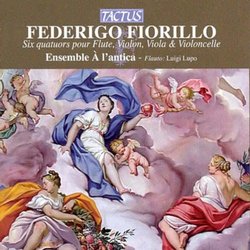| All Artists: Federigo Fiorillo, Luigi Lupo, Atlantic Ensemble Title: Federigo Fiorillo: Six quatuors pour Flute, Violin, Viola & Violoncelle Members Wishing: 0 Total Copies: 0 Label: Tactus Records Original Release Date: 1/1/2007 Re-Release Date: 6/12/2007 Genre: Classical Styles: Chamber Music, Historical Periods, Classical (c.1770-1830) Number of Discs: 1 SwapaCD Credits: 1 UPC: 8007194103885 |
Search - Federigo Fiorillo, Luigi Lupo, Atlantic Ensemble :: Federigo Fiorillo: Six quatuors pour Flute, Violin, Viola & Violoncelle
 | Federigo Fiorillo, Luigi Lupo, Atlantic Ensemble Federigo Fiorillo: Six quatuors pour Flute, Violin, Viola & Violoncelle Genre: Classical
Born in Germany, Federigo Fiorillo (1755-ca. 1823) was descended from a family of Neapolitan musicians: an ancestor, Carlo, had published a book of madrigals in the 16th century, and his father, Ignazio, had made a name... more » |
Larger Image |
CD Details
Synopsis
Album Description
Born in Germany, Federigo Fiorillo (1755-ca. 1823) was descended from a family of Neapolitan musicians: an ancestor, Carlo, had published a book of madrigals in the 16th century, and his father, Ignazio, had made a name for himself in Europe as a composer of operas and maestro di cappella. An excellent violinist and violist, Fiorillo was also a soloist on the mandolin as well as a pedagogue. His Etude pour le violon formant 36 caprices are still well known among violin students today, while harpists practice his seventy-two exercises for harp. In the late 1790s, Fiorillo printed his own six quartets for flute, violin, viola, and cello, possibly modelled on those of Françoise-Andrè Philidor.

 Track Listings (15) - Disc #1
Track Listings (15) - Disc #1